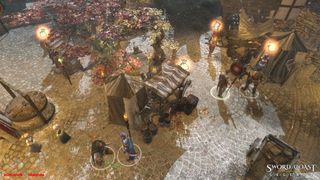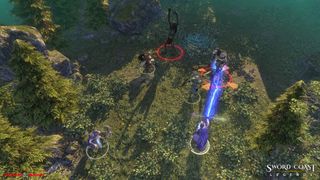Sword Coast Legends' powerful DM tools are promising

There’s a reason movie adaptations of books and comics often suck: books and comics are, to put it simply, not movies. Sometimes ideas don’t translate between mediums and the nuances that defined the original work disappear, or the adaptation is so slavish that the final product feels clumsy and forced. Developers face these same risks when trying to translate a distinctly tabletop experience into a video game.
Fortunately for Dungeons & Dragons fans, isometric RPG Sword Coast Legends not only draws from official Forgotten Realms lore thanks to developer n-Space’s partnership with Wizards of the Coast, it also recreates several of the core experience’s most integral components, including robust character creation options, cooperative party-focused multiplayer, and most importantly, custom campaigns crafted by your own devious dungeon master. Sword Coast’s hands-on demo at E3 2015 showcased the dungeon crafting tools for the first time, giving us an accelerated overview of the impressively granular process.
The custom module du jour focused on locating a lost member of the central protagonist’s fractured guild, the once great Burning Dawn. To start, the developer serving as DM crafted a custom mission-giver—in this case, a ranger named Gwen—from her physical appearance to her general demeanor. He then whipped around the world map before zooming way down to a specific street corner where he placed Gwen, set the mission start condition to “On Speak,” and penned some quick custom dialogue (though DMs can also choose to tell the story over chat).

Then came the dungeon. First, the dev DM ticked a few boxes in an intimidatingly deep menu, selecting broad options like environment type, approximate size, and even weather conditions. Based on these inputs, the game generated a randomized map, and that’s where the real fun began: he carefully placed a custom roster of enemies—complete with custom abilities and custom appearances—in custom locations around the dungeon, whose chambers he then customized with props and traps triggered by scripts. It’s ridiculous and spectacular. You can customize everything down to the last damn cobweb.
Of course, you’re not obligated to. In our case, the developers blazed through the creation process in about five minutes and then immediately turned us loose in the spider-infested hellscape we’d just watched them create—which, if we were playing the game for real, would have become available only after we’d spoken with Gwen. Not only did our mini-adventure give me a chance to delve into a dungeon with a full in-person party, it also gave the developers a chance to show off the final facet of the DM role: direct character control.
As my ad-hoc party and I soon discovered, this custom dungeon housed a particularly nasty sorcerer named Mr. Fancy Pants. When we’d finally battled our way through enough scripted ambushes and scoured the environment with D&D’s classic 'search' mechanic, we found the dread sorcerer guarding our heroes’ missing guild-mate, at which point the DM stepped in to control Mr. Fancy Pants just as the party controlled its player characters. As with classic isometric RPGs like Baldur’s Gate and Diablo, action involves a great deal of point-and-clicking, but fans of D&D Fifth Edition will immediately recognize abilities like Disengage and Misty Step (among many, many others) mapped to number keys. Abilities vary by class, naturally, and require a cool-down period after each use, but they go a long way towards making combat feel true to its source material.
Thanks to the relatively liberal allotment of healing and self-resurrection potions, our party eventually triumphed over Mr. Fancy Pants and his giant spider minion (which the DM also commanded). Though the battle was hard-fought, our DM was kind enough to place custom loot on his own corpse, which of course played into the seemingly equally deep set of character customization options. And while I didn’t get to see it in action, players who’ve always dreamed of leaving their party of flakey friends in the dust will be happy to hear Sword Coast also offered pause-and-play mechanics, which let solo players pause the action and input detailed directions for each PC before allowing the battle to continue. At least you won’t have to share your loot, right?
The biggest gaming news, reviews and hardware deals
Keep up to date with the most important stories and the best deals, as picked by the PC Gamer team.
Digital DMing may not be an entirely new concept, but Sword Coast’s robust combination of level-building and light scripting made for an impressive half-hour. Honestly it’s hard not to be intrigued by the idea that, if you’re DMing and you tell your players they’ll find a certain character in front of a specific tavern and at a particular time of day, you can actually go make that character exist and she will be able to send them on a quest. Our preliminary judgement is that Sword Coast Legends at least ought to be on your radar, and we'll have a better sense of how it truly works in the wild when it releases on September 8.
Most Popular

